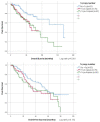The impact of bortezomib-based induction in newly diagnosed multiple myeloma with chromosome 1q21 gain
- PMID: 35465644
- PMCID: PMC9019371
- DOI: 10.1177/20406207221082043
The impact of bortezomib-based induction in newly diagnosed multiple myeloma with chromosome 1q21 gain
Abstract
Introduction: Bortezomib has been reported to favourably impact the outcomes of t(4;14) and del(17p) in multiple myeloma (MM), but its impact on gain 1q (+1q) is unknown.
Methods: To address this, 250 patients treated with bortezomib-based induction were analysed. All myeloma samples had fluorescence in situ hybridization (FISH) performed on CD138-sorted bone marrow aspirate, and plasma cells were analysed using DNA probes specific for the following chromosomal aberrations: del(13q14), del(17p), t(14;16), t(4;14), and +1q. Presence of +1q was defined as the presence of at least three copies of 1q21 at the cut off level of 20% of bone marrow plasma cells.
Results: +1q identified in 167 (66.8%) and associated with t(4;14) and high lactate dehydrogenase (LDH). +1q was not associated with response rate but shorter event-free survival (EFS) (median EFS 35 vs 55 months, p = 0.05) and overall survival (OS) (median OS 74 vs 168 months, p = 0.00025). Copy number and clone size did not impact survival. Multivariate analysis showed +1q was an independent adverse factor for OS together with International Staging System (ISS)3, high LDH, del(17p) and t(4;14). When a risk score of 1 was assigned to each independent adverse factor, OS was shortened incrementally by a risk score from 0 to 4. Post-relapse/progression survival was inferior in those with +1q (median 60 vs 118 months, p = 0.000316). Autologous stem cell transplantation (ASCT) improved OS for those with +1q (median OS 96 vs 49 months, p = 0.000069).
Conclusion: +1q is an adverse factor for OS in MM uniformly treated with bortezomib-based induction but was partially mitigated by ASCT. A risk scoring system comprising +1q, LDH, high-risk FISH, and ISS is a potential tool for risk stratification in MM.
Keywords: chromosomal aberrations; fluorescence in situ hybridization; gain 1q; multiple myeloma; risk stratification.
© The Author(s), 2022.
Conflict of interest statement
Conflict of interest statement: The authors declared no potential conflict of interest with respect to the research, authorship, and/or publication of this article.
Figures





References
-
- Chng WJ, Dispenzieri A, Chim CS, et al.. IMWG consensus on risk stratification in multiple myeloma. Leukemia 2014; 28: 269–277. - PubMed
-
- Walker BA, Leone PE, Chiecchio L, et al.. A compendium of myeloma-associated chromosomal copy number abnormalities and their prognostic value. Blood 2010; 116: e56–65. - PubMed
-
- Hanamura I, Stewart JP, Huang Y, et al.. Frequent gain of chromosome band 1q21 in plasma-cell dyscrasias detected by fluorescence in situ hybridization: incidence increases from MGUS to relapsed myeloma and is related to prognosis and disease progression following tandem stem-cell transplantation. Blood 2006; 108: 1724–1732. - PMC - PubMed
LinkOut - more resources
Full Text Sources
Research Materials

